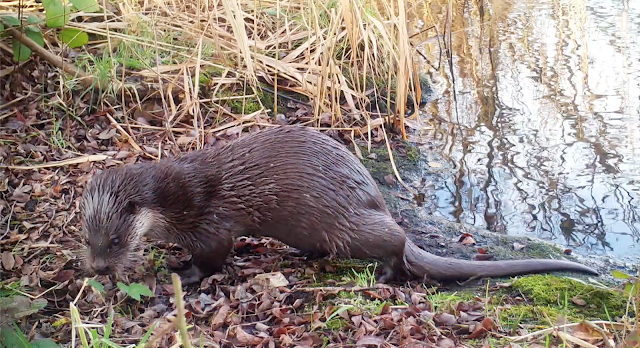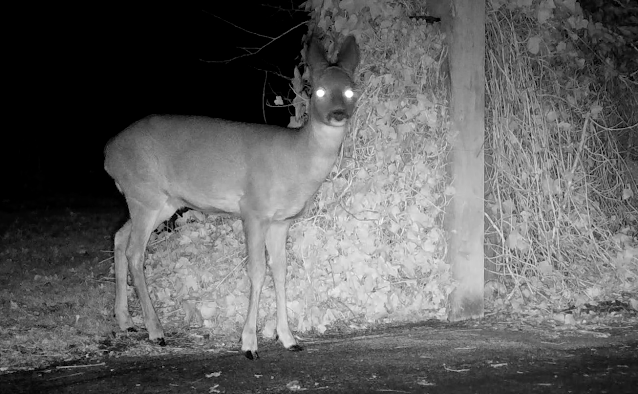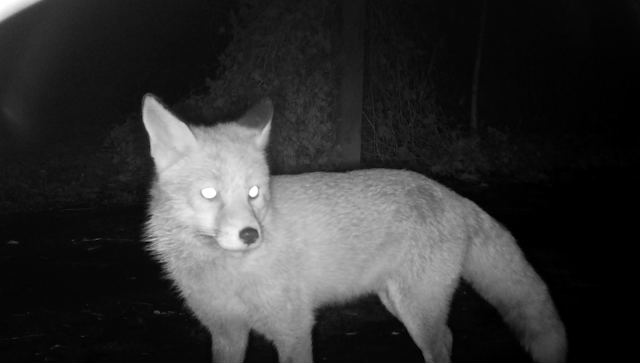The otters have been putting on a show recently, appearing on the cameras several times in daylight. One of the limitations of trail cameras is that the target has to be in the frame before the camera is activated and, with a 400ms activation time, it means that the start of the action is missed, a big deal if it is something very fast like a weasel. Another limitation is that Browning cameras record for only 20s at night, although they will restart very quickly and clips can be stitched together. Just occasionally everything works out perfectly, as in this first video. The dog otter swam into view briefly to activate the camera, disappeared momentarily, and reappeared for about 20s, all of which was recorded as the camera will run for up to 2 minutes in daylight.
My Blog List
Thursday 27 January 2022
OtterCam in January
Friday 21 January 2022
Leaving the gate open
I can't see what is happening at the gate from the house in the dark so I have been using a trail camera to keep an eye on things. I have been leaving the gate open for the deer who come in most nights. Three nights ago the only two here were a buck and a doe but they came in at 2000 and left at 0500, so they were in the garden for nine hours.
In chronological order here is a taste of the action that night. Two deer in and two deer out, eleven foxes in and four foxes out, but the foxes can leave in many other places.
Foxes will do anything for an easy life and I am sure they are delighted I have been leaving the gate open. Usually they have to jump over or through the fence but now they can just stroll in.
Friday 14 January 2022
RoeDeerCam in the garden
I have had roe deer in the garden twice before, in 2018 and 2021, but only at the end of the winter, in late February / early March. I have let them in by leaving the gate open at night after noticing that the ivy has been eaten from the outside of the fence. This time it was eaten before Christmas, suggesting that they are already running out of food. There is a lot of fresh ivy inside so I again left the gate open and set up cameras to watch. After a hesitant start they have been coming in every night and I have been experimenting with camera positions. The visitors include two bucks, at least three does and at least one young doe. (Roe deer don't form herds but often go around in small groups of 2-5 in winter.)
The first to arrive is usually this buck. He sometimes walks with a strange, stiff-legged gait.
The second buck is slightly smaller, has slightly longer antlers and a mark on the left haunch. The antlers are still growing at this time of year and are covered in velvet.
The camera has seen several does who are often here in pairs.
One doe was here with her fawn from last year.
Another doe has a bad limp and hobbles on three legs without putting weight on her right hind leg.
The deer quickly got used to the cameras and seem very relaxed about them.
Friday 7 January 2022
Christmas foxes
My mother's garden is at the edge of a village in Northamptonshire and is separated from the field by a beautiful old oak fence. Smaller animals can just walk in from the field and we have briefly seen a fox and a badger on the trail camera previously. At Christmas weekend I set up a camera again just by the fence.
The first fox to arrive on a cold wet Christmas Eve night was unusual in not having a white tip (tag) to its tail. According to Marc Baldwin's website, 83% of foxes do have a white tip, as do all of mine.







































